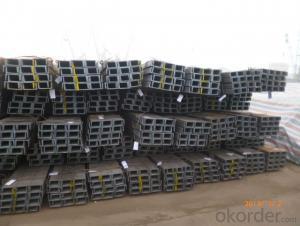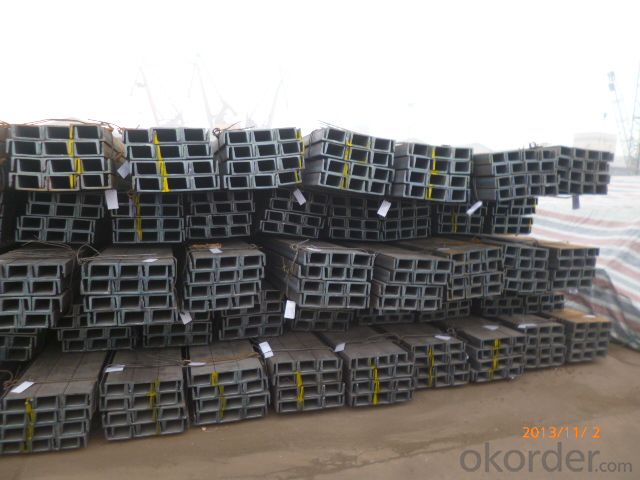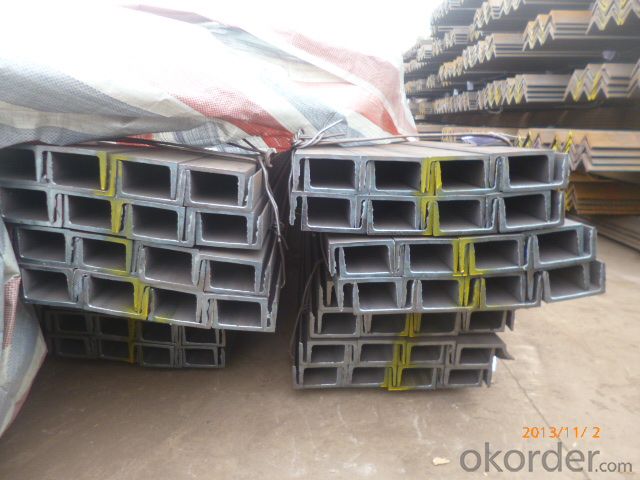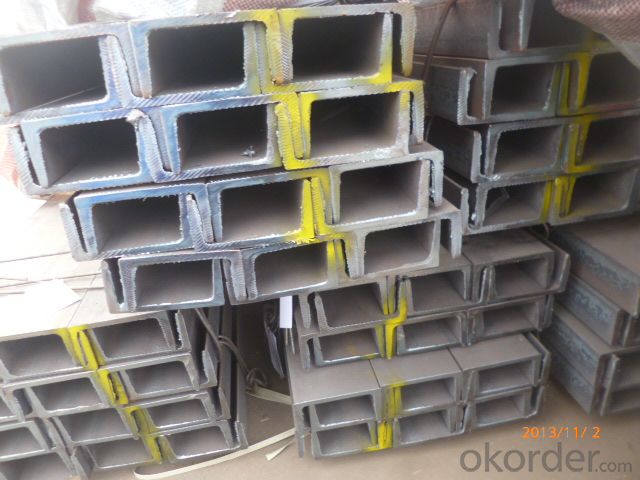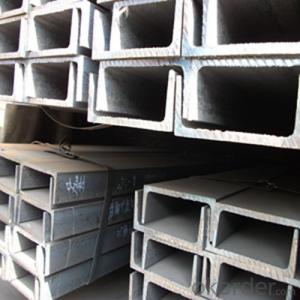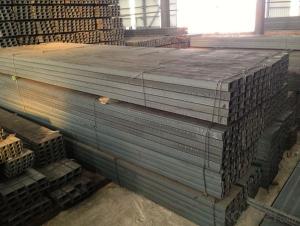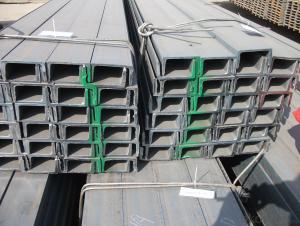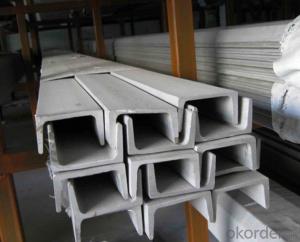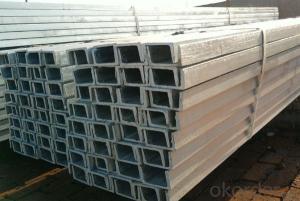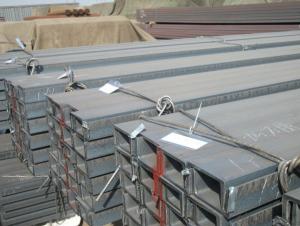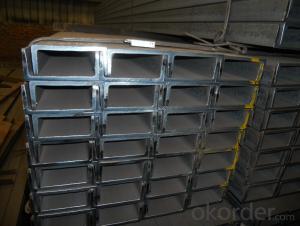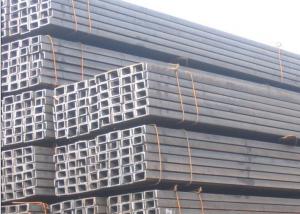JIS U-Channels Hot Rolled with High Quality
- Loading Port:
- Tianjin
- Payment Terms:
- TT OR LC
- Min Order Qty:
- 25 m.t
- Supply Capability:
- 10000 m.t/month
OKorder Service Pledge
OKorder Financial Service
You Might Also Like
Specification
OKorder is offering U-channels at great prices with worldwide shipping. Our supplier is a world-class manufacturer of steel, with our products utilized the world over. OKorder annually supplies products to European, North American and Asian markets. We provide quotations within 24 hours of receiving an inquiry and guarantee competitive prices.
Product Applications:
Japanese Standard U-channels are ideal for structural applications and are widely used in the construction of buildings and bridges, and the manufacturing, petrochemical, and transportation industries.
Product Advantages:
OKorder's Japanese Standard U-channels are durable, strong, and resist corrosion.
Main Product Features:
· Premium quality
· Prompt delivery & seaworthy packing (30 days after receiving deposit)
· Corrosion resistance
· Can be recycled and reused
· Mill test certification
· Professional Service
· Competitive pricing
Product Specifications:
Manufacture: Hot rolled
Grade: Q235/SS400
Certificates: ISO, SGS, BV, CIQ
Length: 6m – 12m, as per customer request
Packaging: Export packing, nude packing, bundled
1. We are definitely speciallizing in manufacturing and supplying channel steel as per japanese standard, which is characterised with high mechanical strength and competitive prices.
Original Place | Tangshan, China | Brand Name | UINDA |
Standard | JIS G3192 : 1990 | ||
Material Grade | SS400 | ||
Sizes | 50mm to 200mm | ||
Sales Volume/Year | 3000MT | ||
Destination Area | Middle East, Africa, Southeast Asia | ||
2. The sections in details are as followings in the table-1
JIS U CHANNEL | Standard | Sectional | Dimension |
| Mass: |
(mm) | (mm) | (mm) | (mm) | ||
50x25 | 50 | 25 | 3.0 | 6.00 | 2.37 |
75X40 | 75 | 40 | 3.8 | 7.00 | 5.30 |
75X40 | 75 | 40 | 4.0 | 7.00 | 5.60 |
75X40 | 75 | 40 | 4.5 | 7.00 | 5.85 |
75X40 | 75 | 40 | 5.0 | 7.00 | 6.92 |
100X50 | 100 | 50 | 3.8 | 6.00 | 7.30 |
100X50 | 100 | 50 | 4.2 | 6.00 | 8.03 |
100X50 | 100 | 50 | 4.5 | 7.50 | 8.97 |
100X50 | 100 | 50 | 5.0 | 7.50 | 9.36 |
125X65 | 125 | 65 | 5.2 | 6.80 | 11.66 |
125X65 | 125 | 65 | 5.3 | 6.80 | 12.17 |
125X65 | 125 | 65 | 5.5 | 8.00 | 12.91 |
125X65 | 125 | 65 | 6.0 | 8.00 | 13.40 |
150x75 | 150 | 75 | 5.5 | 7.30 | 14.66 |
150x75 | 150 | 75 | 5.7 | 10.00 | 16.71 |
150x75 | 150 | 75 | 6.0 | 10.00 | 17.90 |
150x75 | 150 | 75 | 6.5 | 10.00 | 18.60 |
150x75 | 150 | 75 | 6.5 | 10.00 | 24.00 |
200X80 | 200 | 80 | 7.5 | 11.00 | 24.60 |
Table-1
3. The mechanical property of JIS U Channel Steel in the table-2:
Grade | Yield Strength,N/mm² | Extension Strength N/mm² | |||
Thickness of Steel,mm | |||||
≦16 | >16-≦40 | >40-≦100 | >100 | ||
SS400 | ≧285 | ≧275 | ≧255 | ≧245 | 490-610 |
Table-2
4. The chemical composition of JIS U Channel Steel as per SS400 in the table-3
Grade | Element(%) | |||
C | Mn | P | S | |
SS400 | - | - | ≦0.050 | ≦0.050 |
Table-3
FAQ:
Q1: Why buy Materials & Equipment from OKorder.com?
A1: All products offered byOKorder.com are carefully selected from China's most reliable manufacturing enterprises. Through its ISO certifications, OKorder.com adheres to the highest standards and a commitment to supply chain safety and customer satisfaction.
Q2: How do we guarantee the quality of our products?
A2: We have established an advanced quality management system which conducts strict quality tests at every step, from raw materials to the final product. At the same time, we provide extensive follow-up service assurances as required.
Q3: The products are invoicing on theoritical weight or on actual weight?
A3: We can do it in both manners, according to the customers' request.
Images:
- Q: How do steel channels contribute to structural stability?
- Steel channels contribute to structural stability in several ways. Firstly, they provide added strength and support to the structure. The shape of steel channels, with their wide base and narrow top, allows them to bear heavy loads and resist bending or twisting forces. This makes them ideal for use in beams, columns, and other structural members. Furthermore, steel channels can be used as reinforcement within concrete structures. When embedded in concrete, they enhance the overall strength and durability of the structure. Steel channels help distribute the load across a larger area, reducing stress concentrations and preventing localized failures. In addition, steel channels can be interconnected to form a framework, increasing the rigidity of the structure. By connecting steel channels in a network, they create a system that resists lateral forces such as wind or earthquakes. This helps maintain the stability of the structure and prevents it from collapsing or being damaged during extreme events. Moreover, steel channels are highly resistant to corrosion, which is essential for long-term structural stability. Unlike other materials, steel channels do not deteriorate easily when exposed to moisture, chemicals, or extreme temperatures. This durability ensures that the structural integrity of the building remains intact over time. Overall, steel channels play a vital role in enhancing the structural stability of buildings and other structures. Their strength, versatility, ability to reinforce concrete, and resistance to corrosion make them an indispensable component in construction.
- Q: What are the typical finishes available for steel channels?
- There are several typical finishes available for steel channels, depending on the desired aesthetic appeal and functional requirements. One common finish is hot-dip galvanizing, where the steel channel is dipped in a bath of molten zinc. This process provides excellent corrosion resistance, making it suitable for outdoor applications or environments where the channel may be exposed to moisture or chemicals. The zinc coating also adds a decorative appearance, with a shiny and uniform surface. Another option is powder coating, which involves applying a dry powder onto the steel channel and then curing it under heat. This finish provides a durable and attractive coating that is resistant to chipping, scratching, and fading. Powder coating can be customized in various colors, allowing for aesthetic flexibility and integration with the surrounding environment. Electroplating is another popular finish for steel channels. It involves immersing the channel in an electrolyte solution and passing an electric current through it, causing a layer of metal (such as chrome or nickel) to be deposited onto the surface. Electroplating enhances the appearance of the channel, providing a smooth and shiny finish while also offering some corrosion resistance. For a more natural and rustic look, steel channels can be left unfinished or with a bare metal finish. This option is often chosen for industrial or architectural designs where the raw and exposed metal is desired for its aesthetic appeal. In summary, the typical finishes available for steel channels include hot-dip galvanizing, powder coating, electroplating, and bare metal finishes. Each finish offers its own unique benefits in terms of corrosion resistance, durability, appearance, and customization options, allowing for a wide range of applications and design possibilities.
- Q: What are the considerations for steel channel connections to timber structures?
- When considering steel channel connections to timber structures, there are several important factors to keep in mind. Firstly, it is crucial to ensure that the connection is structurally sound and able to withstand the required loads and forces. This involves carefully calculating and designing the connection to ensure that it can bear the expected load without failure. Secondly, compatibility between steel and timber should be considered. Different materials have different expansion and contraction rates, so provisions must be made to accommodate these movements and prevent any potential issues, such as splitting or excessive stress on the connection. Additionally, the connection should be designed to prevent corrosion, as steel is susceptible to rusting. Proper measures, such as using protective coatings, galvanizing, or isolating materials, should be implemented to minimize the risk of corrosion and ensure the long-term durability of the connection. Lastly, it is important to follow applicable building codes and regulations when designing and constructing steel channel connections to timber structures. These codes provide guidelines and standards that must be adhered to in order to ensure the safety and structural integrity of the connection.
- Q: Standard for channel 20
- According to the GB / T 707 - 1998 hot-rolled steel GB, No. 20 channel is divided into: 20A; 20b two.20A: height: 200 mm width: 73 mm thickness: 7 mm weight: 22.637 kg / m theory.20b: height: 200 mm width: 75 mm thickness: 9 mm weight: 25.777 kg / m theory.(Note: the theoretical weight calculation of steel hot-rolled steel according to the density of 7.85 g / cm3)
- Q: How do steel channels contribute to acoustic performance?
- Various applications can benefit significantly from the use of steel channels to improve acoustic performance. One of the main advantages of steel channels is their ability to minimize sound transmission and enhance sound insulation. When incorporated into wall or ceiling systems, steel channels act as a barrier that prevents sound from traveling between different spaces. The design and construction of steel channels allow for the installation of sound insulation materials, such as mineral wool or acoustic foam. These materials effectively absorb and dampen sound waves, reducing the transmission of noise from one area to another. By integrating steel channels into the construction of walls or ceilings, the overall acoustic performance of a space can be greatly enhanced. Steel channels not only excel in sound insulation but also contribute to the improvement of room acoustics. For instance, by utilizing steel channels to create a suspended ceiling, a more balanced and controlled sound environment can be achieved. The space between the steel channels can be filled with acoustic tiles or panels, which absorb sound reflections and minimize echoes, resulting in better speech intelligibility and overall sound quality. Furthermore, steel channels can also be utilized to support the installation of sound-absorbing materials on walls or ceilings. Materials such as fabric-wrapped panels or perforated metal sheets help reduce reverberation and echo in a room, thereby enhancing its acoustic performance. Steel channels provide a reliable framework to securely mount these materials, ensuring their effectiveness in enhancing sound absorption. In summary, steel channels contribute to acoustic performance by reducing sound transmission, improving sound insulation, and enhancing room acoustics. Whether used in the construction of walls, ceilings, or as a support for sound-absorbing materials, steel channels play a pivotal role in creating a more acoustically favorable environment, be it in residential, commercial, or industrial settings.
- Q: How do steel channels contribute to ventilation in structures?
- Ventilation in structures can be enhanced through various means, with steel channels being a key contributor. Primarily, these channels serve as vital components of ventilation systems, effectively guiding and dispersing airflow throughout the building. By strategically positioning them, a constant supply of fresh air can be brought in while eliminating stagnant air. Moreover, steel channels serve a secondary purpose by providing support for ventilation equipment, including fans, blowers, and air conditioning units. By securely affixing these devices onto the channels, they can efficiently circulate and distribute air throughout the entire structure. In addition, steel channels offer the opportunity to construct air ducts within the building. These ducts facilitate the movement of air from one area to another, ensuring proper distribution and reaching all corners of the structure. By employing steel channels for this purpose, the ducts become robust, long-lasting, and resistant to damage, ultimately resulting in efficient and enduring ventilation. In conclusion, steel channels play an indispensable role in the ventilation of structures. Not only do they provide support for ventilation equipment, but they also assist in directing airflow and creating durable air ducts. By incorporating steel channels into ventilation systems, structures can maintain optimal air quality, temperature, and circulation, thus fostering a comfortable and healthy environment for occupants.
- Q: Can steel channels be used in bridges and flyovers?
- Yes, steel channels can be used in bridges and flyovers. Steel channels are commonly used in the construction of bridges and flyovers due to their strength, durability, and versatility. They are often used as structural elements in the design of these structures to provide support and stability. Steel channels offer excellent load-bearing capacity, which is essential for withstanding the weight and forces exerted on bridges and flyovers. Additionally, steel channels can be easily fabricated and installed, making them a preferred choice in the construction industry. Overall, steel channels are widely utilized in bridges and flyovers to ensure the safety and longevity of these infrastructure projects.
- Q: What is the difference between the main keel and the angle steel and the channel steel?
- Channel steel is a strip of steel with a cross section. Section steel with groove shape.Channel steel is a kind of carbon structural steel used for construction and machinery. It is a complex section steel. Its cross section has a groove shape. Channel steel is mainly used in building structure, curtain wall engineering, mechanical equipment and vehicle manufacturing, etc.. In use, it requires better welding, riveting performance and comprehensive mechanical properties. The raw material steel billet for channel steel is carbon or low alloy steel billets with a carbon content of not more than 0.25%. The finished channel steel is delivered by hot forming, normalizing or hot rolling. The specifications are expressed in millimeters of height (H) * leg width (b) * waist thickness (d), such as 100*48*5.3, which means waist height is 100 mm, leg width is 48 mm, waist thickness is 5.3 mm channel, or 10# channel steel. The same height of the channel, if there are several different leg width and waist thickness, also need to add a, B, C on the right side of the model to distinguish, such as 25#a, 25#b, 25#c and so on.
- Q: How do steel channels contribute to the overall efficiency of a structure?
- Steel channels contribute to the overall efficiency of a structure by providing strength, stability, and support. They are commonly used as structural members in various applications such as building frames, bridges, and industrial equipment. The shape of steel channels allows for efficient distribution of loads, reducing the amount of material required and minimizing the weight of the structure. Additionally, their high strength-to-weight ratio enables them to withstand heavy loads and resist bending or twisting, ensuring the longevity and durability of the structure. Furthermore, steel channels can be easily fabricated, assembled, and connected, making construction faster and more cost-effective. Overall, the use of steel channels enhances the structural integrity and efficiency of a building or infrastructure project.
- Q: What are the different surface treatments for steel channels?
- Steel channels have various surface treatments available, each serving a specific purpose and offering distinct advantages. Examples of common treatments include: 1. Hot-dip galvanizing, where the steel channel is immersed in molten zinc, resulting in a durable coating that provides excellent corrosion resistance. This treatment is ideal for outdoor applications and environments with high humidity or exposure to harsh chemicals. 2. Powder coating involves applying a dry powder to the steel channel's surface, which is then cured under heat to form a protective layer. This treatment offers a wide range of color options, enhances aesthetics, and provides good resistance against corrosion, abrasion, and UV damage. 3. Electroplating deposits a thin layer of metal, like zinc or chromium, onto the steel channel's surface using an electric current. This treatment improves the channel's appearance, corrosion resistance, and can impart specific properties like increased hardness or conductivity. 4. Paint coating involves applying paint to the steel channel, offering both aesthetic appeal and protection against corrosion. Paint coatings come in various colors and application techniques, such as spraying or brushing. However, they may not be as long-lasting as other treatments and may require periodic maintenance. 5. Anodizing, primarily used for aluminum channels but also applicable to steel channels, creates an oxide layer on the surface through an electrochemical process. This treatment enhances corrosion resistance and provides a decorative finish, commonly used in architectural applications. When selecting the most suitable surface treatment for steel channels, it is vital to consider factors such as the intended use, environmental conditions, and desired aesthetics. Seeking advice from professionals or experienced suppliers in steel treatments can help determine the optimal option for specific requirements.
Send your message to us
JIS U-Channels Hot Rolled with High Quality
- Loading Port:
- Tianjin
- Payment Terms:
- TT OR LC
- Min Order Qty:
- 25 m.t
- Supply Capability:
- 10000 m.t/month
OKorder Service Pledge
OKorder Financial Service
Similar products
Hot products
Hot Searches
Related keywords
